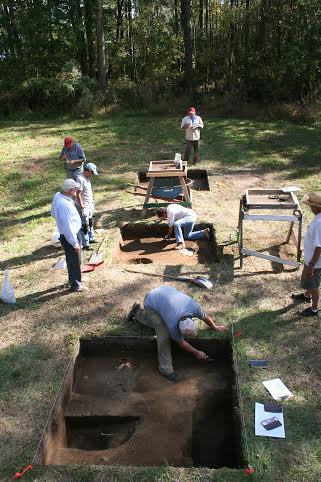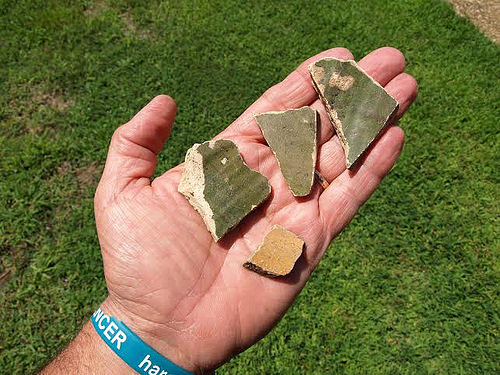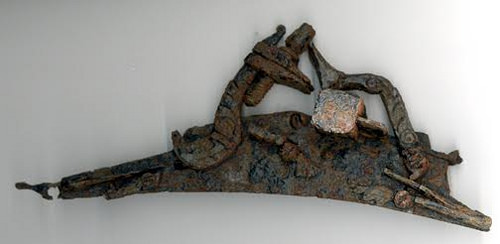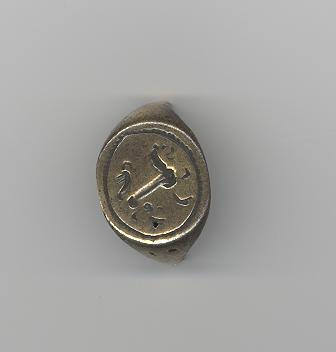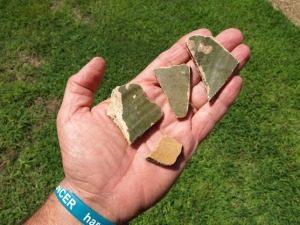 OLYMPUS DIGITAL CAMERA
OLYMPUS DIGITAL CAMERA Archaeologists who have surveyed and dug for decades on Roanoke Island and other locations in North Carolina have accumulated important, albeit comparatively scant, evidence that have raised new questions about the whereabouts of America’s first main English settlement location and the mystery of the ‘lost colony’ of 1587.
Busy at work at a site known as Salmon Creek (otherwise known as ‘Site X’), which has yielded evidence of a long-gone Native American village settlement not far from the waterline on land bordering the Western Albemarle Sound of North Carolina, archaeologists have recently recovered some tantalizing fragments. Among scores of artifacts that tell of the 16th-17th century presence of Native Americans at the location, the archaeologists have uncovered artifacts that are clearly European in origin. The finds included 27 sherds representing perhaps 4 vessels of 16th century Surrey-Hampshire Border ware; 3 sherds of a North Devon plain baluster jar—a ceramic ware commonly used during the 16th and 17th centuries as provisioning jars on sea voyages—a tenter hook, of a type similar to that used at the early Jamestown settlement and possibly used to stretch canvas to create temporary shelters or to stretch and dry animal skins; a priming pan from an early (possibly 16th century) flintlock gun as well as another possibly from a 16th century snaphaunce gun; an aglet of the type that would have secured Elizabethan clothing; a fragment from an iron buckle typical of the style worn in the 16th and 17th centuries; and a lead cloth seal that may possibly be 16th or 17th century. The site investigators say that the finds are significant in that the earliest recorded presence of English settlement in the western Albemarle Sound area did not occur earlier than about 1655.
______________________________________________
Excavations underway at the Salmon Creek site, or ‘Site X’. Courtesy First Colony Foundation
___________________________________________________________
Sherds of yellow and green glazed Surrey-Hampshire Border Ware, excavated from Site X. Courtesy First Colony Foundation
______________________________________________________________
The recent findings have made news headlines at a variety of venues in 2015. But is it unequivocal evidence for the long-sought whereabouts of the famous ‘lost colony’ of 1587?
Yes and no, say the archaeologists of the First Colony Foundation, the organization under which recent excavations have been conducted at the site.
“The First Colony Foundation believes [hypothesizes] that it has uncovered archaeological evidence of Roanoke colonists’ presence at Site X,” write the site investigators in their report.* However, they qualify their statement with another statement documented in the same report: They “do not contend that Site X on its own represents the relocation site for the majority of 1587 colonists.”* They suggest that any habitation by Roanoke colonists at the site may have only consisted of a small surviving part of the original 1587 group.
So where did the rest go?
When colony Governor John White finally returned in 1590 to the 1587 settlement site after three frustrating years held in England due to the British Crown’s maritime conflict with Spain, he found them vanished, with no trace of their whereabouts other than the word ‘Croatoan’ carved into a tree or post at the abandoned settlement site. The Croatoans were Indians who inhabited an area in present-day Hatteras Island, in the southern North Carolina Outer Banks. His subsequent search effort in that direction ended in failure, after which he returned to England, never to see the colonists again. But recent excavations at a site known as Cape Creek on Hatteras Island have turned up, like Site X further north and west, some compelling artifacts that could give clues about a 16th century European presence there. Under a joint effort in 2015 carried out by Bristol University and the Croatoan Archaeological Society, findings at that site have included a small fragment of slate that may have been used as a writing tablet (showing a small letter “M” in one corner and found near a lead pencil) similar to that found at the 1607 James Fort excavations on Jamestown Island, Virginia; a part of the hilt of an English iron rapier (a sword of the type used in England during the 16th century); an iron bar; and a large copper ingot. But even before that, in 1998, investigations of the site by archaeologists under a East Carolina University project yielded a 10-carat gold signet ring thought to date to the 16th century. Engraved with the image of a lion or horse, it is suggested that it likely originally belonged to an English gentleman, as such items would have been more typically worn by English noblemen.
“We interpreted the site as a 17th century Croatoan Indian workshop complete with hearths for working and lots of metal working related items,” said Edward “Clay” Swindell, a key archaeologist who participated in the 1998 excavations where the signet ring was found. But he expresses an air of caution. “We need to be very careful about how we interpret our finds at these sites,” he emphasizes. “It’s easy to catch the ‘fever’ of looking for the ‘lost colony’, and this can color our conclusions. We’re looking at sites that bear a paltry few artifacts (related to European presence), and so it’s easy to cave into the temptation of saying, ‘this is it’ about the lost Roanoke settlement or the lost colony.”
________________________________________________
16th century gunlock excavated at Cape Creek site. Courtesy Dr. David S. Phelps and Charles L. Heath
__________________________________________________________________
16th century gentleman’s signet ring excavated at Cape Creek site. Courtesy Dr. David S. Phelps and Charles L. Heath
_____________________________________________________________________
In any case, though it appears that the original ‘lost colony’ group may have possibly split into smaller groups, for whatever reasons, and dispersed to different locations, excavations will continue at both locations and the archaeologists maintain that much more evidence must be unearthed and interpreted before any reasonable conclusions can be securely drawn about the how and where of the lost colonists’ fate.
Archaeologically speaking, however, a much larger question revolves around the actual location of the original 1587 main settlement site. For decades, it has been traditionally thought that the first colony site was located in the northern part of Roanoke Island. Since 1947, when National Park Service archaeologist Jean “Pinky” Harrington first began excavations, a succession of archaeologists have uncovered 16th century European artifacts at four different but closely associated sites in the area of the present-day Fort Raleigh National Historic site visitor center and museum. The museum displays some of the more significant relevant finds. But those sites, according to the archaeologists, have not yielded any evidence that would support domestic habitation, as has been found at the Jamestown (1607 James Fort) site much further north in Virginia. Now, archaeologists suggest that the main Elizabethan settlement likely may not be found in the vicinity of the Fort Raleigh National Historic site, but farther south and west on the island. The ‘Fort Raleigh’ sites may have actually only been northern extensions or stations connected to the larger domestic settlement located elsewhere.
With this, Popular Archaeology asked Swindell where he thought the main settlement might actually be located.
“Even Pinky suspected that the main settlement and fort was down south in the vicinity of Shallowbag Bay,” said Swindell.
Roanoke’s main town of Manteo abuts Shallowbag Bay, home to the town’s main marina and an ideal waterfront for docking boats of a variety of capacities. “This is a nice, deep area for portage and docking,” he says. “The entrance to the Outer Banks is more easily accessible. You have this nice sheltered bay that better accommodates the docking of ships. So you can imagine that this would be a better place to protect your ships and to actually bring supplies in, whereas toward the north (where the current archaeological sites are) there is really no (workable) place to keep your boats and offload supplies.”
Some (unprovenanced) small finds have popped up in the Shallowbag Bay area, but none of them have been pursued archaeologically, said Swindell. “We are hoping to pursue some of these leads, among other things.”
According to Swindell, there are plans to hopefully return to Roanoke to investigate more areas in search of the main colony site. For now, however, eyes and resources are focusing on places like Site X, where archaeologists hope to uncover more finds that will shed light on one of America’s most compelling historical mysteries.
A more in-depth feature article, Unearthing New Clues to America’s First English Colony, is published in the Winter 2015/2016 issue of Popular Archaeology Magazine.
______________________________________________________________
* From First Colony Foundation Report, An Archaeological Brief for Site X.
______________________________________________________________
In addition, the latest Popular Archaeology ebook is now available.
______________________________________________
Travel and learn with Far Horizons.
____________________________________________
This richly illustrated issue includes the following stories: Two remarkable discoveries that are shedding light on human beginnings in Africa; a traveling exhibit and an archaeological site that show how knowledge is more valuable than gold; a Spanish cave and a unique burial that are offering a tantalizing glimpse on the lives of Ice Age hunter-gatherers in Europe; the stunning visual reconstruction of an ancient Roman town; enlightening new finds at a remarkably well-preserved site of ancient Hellenistic-Roman culture overlooking the Sea of Galilee; rare finds that are shedding light on occult practices among ancient Greeks in Sicily; and an overview of the overwhelmingly rich archaeological heritage of Britain. Find it on Amazon.com.

